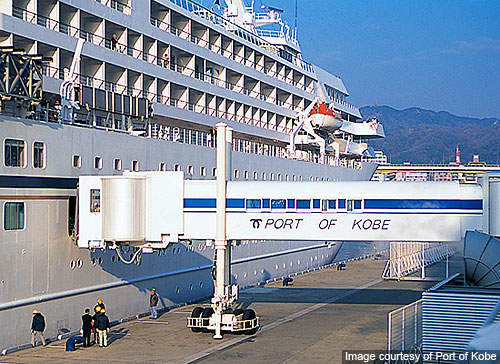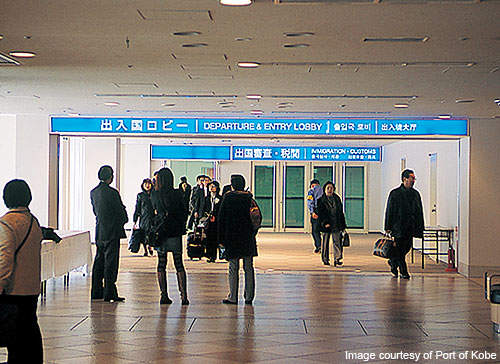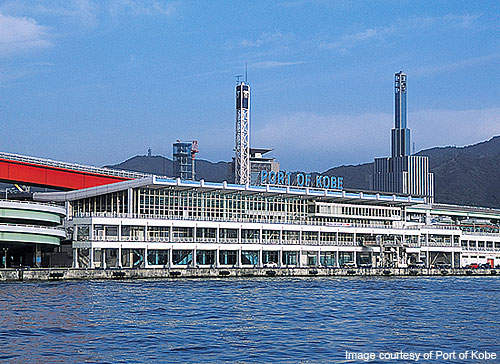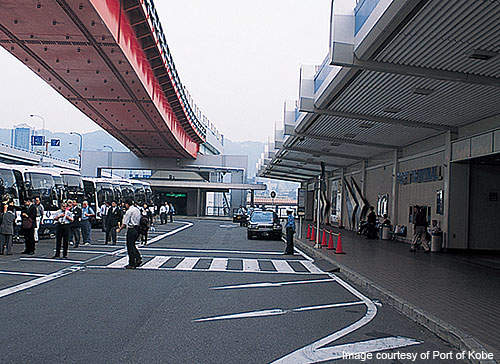Port of Kobe is the fourth busiest port in Japan. It is located in the central part of the Japanese Archipelago and lies on the major routes of international marine-transportation networks, connecting over 500 ports in 130 countries. The port is not only an important commodity distribution centre but also a popular amusement centre.
The port has a beautiful landscape with the Rokko Mountains at its rear and the City of Kobe nearby. The Rokko Mountains also protect the port by blocking the seasonal winds. The port stretches from east to west and can be accessed from various directions.
Major steel and shipbuilding companies have set up their industries at Kobe due to its strategic location. Food products, small appliances, communications and transportation equipment are also manufactured here.
Port of Kobe history
The Port of Kobe was opened in 1868 and was known as Hyogo Port. It was one of the first ports of Japan to trade with the West. It was directly controlled by the central government of Japan under the Tokugawa Shogunate. Tokugawa Shogunate, however, was dissolved in 1868. After the abolition of the Han (traditional feudal) system in 1871, the port became a politically distinct area. The port was given city status in 1956 through a government ordinance.
Allied Forces bombarded the port using B-29 bombers during the World War II in 1945, killing 9,000 people and destroying one-fifth of the urban area. In 1975, the city council prohibited ships loaded with nuclear weapons to enter the port. As a result, US warships were prevented from entering the port.
In 1995, the port was struck by the Great Hanshin earthquake, recording 7.3 on the Richter scale.
Over 212,000 people became homeless and about 4,600 people were killed. Much of the port’s facilities and services were destroyed and halted by the earthquake. The reconstruction works were completed in 1997.
Port of Kobe construction
The Port of Kobe was officially opened in 1868. Kobe Port Tower was completed in 1963.
The reclamation of Port Island was commenced in 1966 and was completed in 1981.
The construction of Port Terminal and Kobe Ohashi Bridge was completed in 1970.
The construction of Meriken Park, which began in 1983, was completed in 1987.
The Harbour Highway became fully operational in 1993.
Efforts to reconstruct the port facilities that were destroyed after the earthquake in January 1995 were begun in March 1995 with the support of the Japanese Government. Container handling operations of the port resumed at Maya Wharf in March 1995.
Six berths of the port were reopened in April 1995 by the Kobe Port Terminal Corporation.
In 2007, the harbours located in Osaka Bay were integrated into a single harbour, known as Hanshin Harbor, under the Port Regulations Law.
Port of Kobe operator
The Port of Kobe is administered by the Kobe City Government, while Kobe Port Terminal Corporation (KPTC) is responsible for building, leasing and maintaining the port terminals including container, liner and ferry terminals.
Port of Kobe facilities
The Port of Kobe can be accessed conveniently by sea, air and land transportation systems from various Japanese regions. Kobe Airport was opened in 2006. Apart from major international routes, the Port of Kobe is also served by many domestic routes.
The Rokko Island Ferry Terminals consist of three berths, RF1, RF2 and RF3. Berth RF1 has been leased to The Diamond Company. The berth has a water depth of 7.5m, length of 193m and terminal area of 17,390m². It provides services on Kobe-Oita route. RF2 has a water depth of 9m, length of 266m and terminal area of 24,920m².
It is operated by Hankyu Ferry Company which provides services on the Kobe-Shinmoji route. RF3 terminal, covering an area of 22,690m², has a berth length of 238m and an alongside depth of 8.5m. This terminal is operated by Shikoku Kaihastu Ferry.
The Rokko Island Container Terminals have four berths with a total area of 612,500m². All these berths have a water depth of 14m. Three of the berths are 350m long while the fourth is 530m. Berths RC4 and RC5 are operated by Nitto Total Logistics and Mitsubishi Logistics Corporation, while RC6 and RC7 are operated by Mitsubishi Logistics Corporation, UNI-X Corporation and Nippon Container Terminal.
The Port Island Container Terminals cover a total area of 786,880m² and contain six berths. These terminals are operated by The Sumitomo Warehouse, Shosen Koun, Sankyu, Nickel & Lyons, The Mitsui Soko and Kamigumi.
The Port Island’s KPTC Conventional Liner Terminals have an alongside depth of 10m and a length of 200m.
The combined terminal area is 241,345m² and the transit shed floor area is 68,926m².
The Naka Pier Cruise Terminal and Kobe Port Terminal are the two cruise terminals at the Port of Kobe. The Naka Pier Cruise Terminal handles medium-sized passenger vessels. It has a length of 286m, an alongside depth of 9m and an apron depth of 20m. The average tidal range of the terminal is 1m.
The Kobe Port Terminal comprises six berths, three on each side of Shinko Pier No. 4. Berths Q1, Q2 and R are located on the east side and have a total length of 649m. Located on west side, berths O1, O2 and P have a total length of 589m.
Port security
Naka Pier and Shinko Pier No.4 are equipped with an X-ray machine and a metal detector for cargo screening. These terminals are guarded by security guards who are positioned at the gates.
The terminals also abide by the International Ship and Port Facility Code (ISPS Code).







